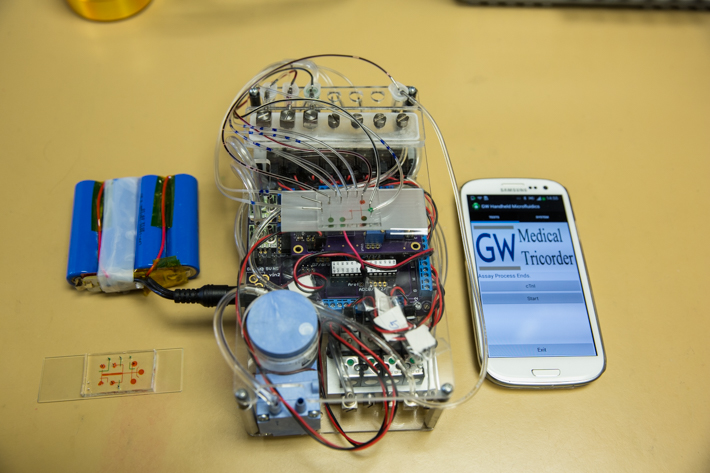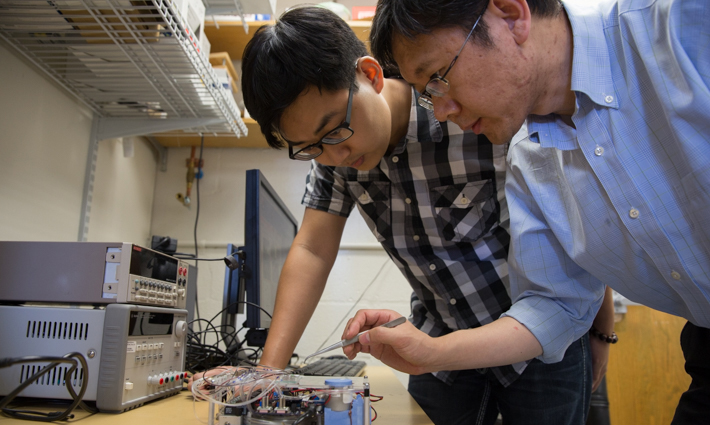A patient sometimes waits days to receive a diagnosis after a trip to the doctor’s office or a patient testing service center. And for those suffering from time-sensitive health conditions, like heart attacks or strokes, a quick diagnosis could mean the difference between life and death.
What if there was a way to test and diagnose a person within minutes?
Two researchers in the George Washington University School of Engineering and Applied Science are developing technologies that would be able to do just that. Zhenyu Li, an assistant professor in the Department of Biomedical Engineering, and graduate student Baichen Li have created a smartphone-controlled liquid handling system that could make handheld health care testing a reality.
Typically, trained personnel use cumbersome machinery to test patients’ blood, urine and saliva samples in centralized labs. The technique is expensive and time consuming.
Dr. Zhenyu Li’s technology miniaturizes that process into a single device that can fit into the palm of your hand. The system is operated by a smartphone, which, with the help of a mobile app that was also designed by the two researchers, displays test results within 15 minutes.
“Now you can bring the lab to the person,” Dr. Li said. “The main aim—and of course it’s a long-term goal—is to completely decentralize medical diagnostics.”
The instrument could be used in physicians’ offices or emergency rooms, providing a cheaper, faster alternative to standard diagnostics tests. In the future, the handheld device could be sold to individual consumers, so people would be able to monitor their health in their homes. For example, a patient prone to heart attacks could test for the presence of cardiac Troponin I, a biomarker for the condition. If the device detected high levels of Troponin in the blood, then he could immediately seek help rather than waiting for test results to return from a lab. Alternatively, this technology would be ideal for patients in developing countries who do not have access to laboratory services.

This device, created by Assistant Professor of Biomedical Engineering Zhenyu Li and SEAS graduate student Baichen Li, uses a tiny fluidic chip (bottom left) that fits inside a microfluidic liquid handling system. The device is operated by a smartphone and a mobile application.
Dr. Li is an expert in microfluidics—the science and technology of manipulating and controlling small volumes of fluids through tiny channels. His first challenge in creating his diagnostic instrument was to develop a tiny fluidic chip that could perform laboratory operations on a small scale. To achieve this, the researchers used advanced microfluidic technology to build complex liquid networks, valves and pumps all on a stamp-sized rubber chip.
While other researchers are working on similar “lab-on-a-chip” technologies, most of these chips still require bulky machinery such as syringe pumps and computers to operate, making them less than ideal for point-of-care medical testing.
That left Dr. Li with one big question to answer: How do you downsize the electronic control, pressure and valve systems that pump the fluids into the microscopic chip?
To overcome this challenge, the researchers developed a compact microfluidic liquid handling system that fits in the palm of your hand. It provides two different pressure sources and eight pneumatic control lines for operating the chips. The researchers then designed a smartphone app, which puts the entire process in motion.
A paper on this handheld liquid handling device was published this month in Lab on a Chip. This research is sponsored by the National Science Foundation.
The researchers still have a few technical issues to address before their device is perfected. They would like to make the microfluidic chip more inexpensive, disposable and the system lighter weight. They also are developing ways for the system to be able to perform multiple tests at once.
Though it may be a few years before the device is sold in an electronics store near you, Dr. Li considers the liquid handling system to be one of his team’s biggest breakthroughs.
“This instrument is the first of its kind that is truly handheld,” Dr. Li said. “It can handle very small liquid samples at point-of-care, making it perfect for quick and sensitive diagnostic tests. We are very excited about it.”


